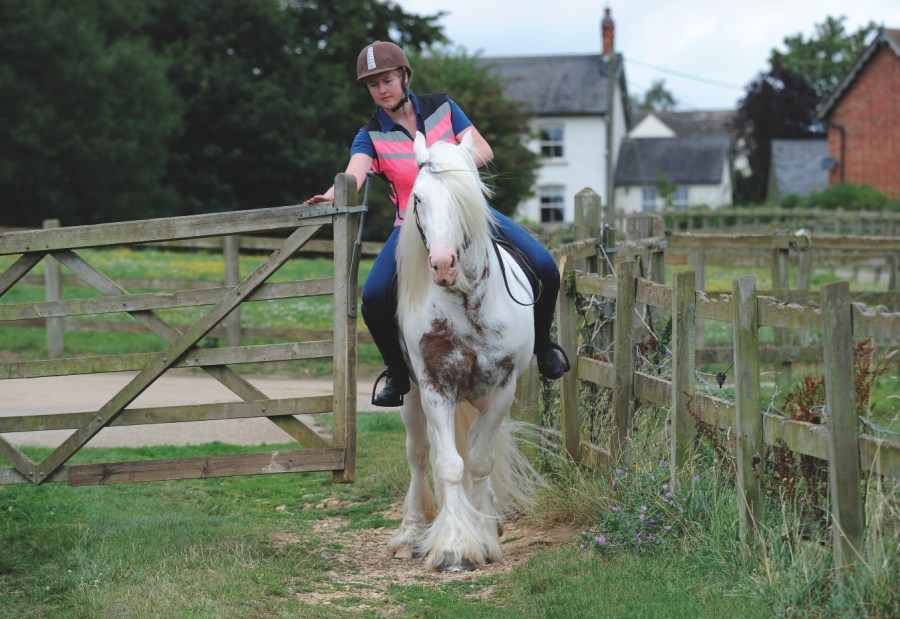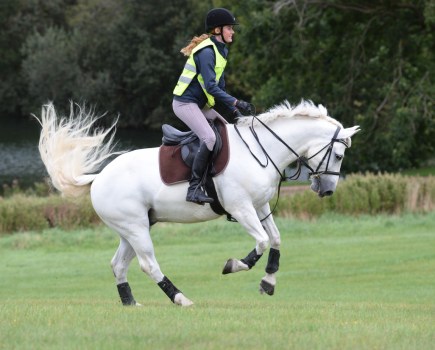If you enjoy hacking, it’s likely that you’ll be faced with a gate to open and close at some point so that you and your horse can continue on your chosen route.
Of course, dismounting and opening it on foot is an option, but nothing ruins a good ride (or wastes time) quite like having to walk a long way to find something to stand on so that you can remount because your horse won’t stand still while you open the gate on board.
How to open a gate on board
For a gate that needs to be pulled towards you:
- Don’t allow your horse to face the gate — some horses have been known to try and jump it, while others may push it forward out of your hands.
- Ride alongside the gate and halt when your horse’s head is just past the catch.
- Make sure your reins and whip* (if you carry one) are in your outside hand, leaving your other hand free.
- Lean forward and down and undo the gate catch. Be careful not to let your lower leg slip back and give your horse the ‘go forward’ aid.
- Pull the gate open slowly, asking your horse to walk forward with the gate and then turn-on-the-forehand so that they don’t block it from opening.
- From this position, gently pull the gate closed while asking your horse to reinback (step back). Don’t let go until you hear (or feel) the catch close.
- If you have to let the gate go after undoing the catch, wait until your horse is clear before you do so in order to prevent them getting caught.
- Now the horse is on the other side of the gate, repeat steps 2 and 3 (but don’t walk beyond the catch), and then slowly ask the horse to step sideways as you pull the gate closed.
For a gate that needs to be pushed away from you:
- If they swing well, these gates are a lot easier.
- Follow steps 2, 3 and 4 above.
- When you have opened the catch, push the gate and ask the horse to walk forwards with it.
- If you’re able to keep hold of the gate and don’t let it go, turn your horse around, taking care not to bang their hindquarters on the gatepost.
- Now ask your horse to walk forward so that you can push the gate shut.
- Fasten the catch with your free hand.
- If you do let the gate go, you’ll need to get behind the gate so that you’re in the best position for closing it.
*In my experience, a whip just gets in the way (unless it has a handy hook on the end for pulling gates), so I stick it in my boot rather than risk dropping it!
How to train a horse to open a gate
What’s the secret to training a fidgety horse to stand while you open a gate or remount? We asked the #Hack1000Miles community for their top tips and this is what they said:
1 Persistence is key
“Do every gate you ever come to. Don’t be afraid to get off. Be over the top with positive praise when the horse stands still,” – Matt Turner.
2 Do the ground work
“I teach my horses to draw their quarters in when mounting. Sideways softness is key either for mounted gate opening or parking up to mount [off a bank or something similar],” – Lisa Dixon.
3 Build trust on the ground
“Use voice commands and start them in the stable. When I open a gate while onboard, I teach my horse to push the gate open. Then you won’t need to remount,” – Kay Conway.
4 Use treats as a reward
“One when they stand at the gate and another when you get back on. This has worked for all of mine, including an ex-racer. I can mount from anywhere now,” – Amanda Hamley.
5 Teach them to halt
“Reward them for standing still while you do up the girth, clip on an air jacket etc. If they happen to move before you’re ready, reposition and ask them to wait until you’re ready,” – Sue Squirrell.
“Clicker training and treats work. Plus teaching them to move their hind quarters over towards you if they’re not straight. Keep relaxed once you’re on and halt until you ask them to move away,” – Jen Birtchnell.
6 Try Trec
“I can’t remount from the ground so I went to a Trec clinic which is fantastic for teaching you and your steed to tackle obstacles such as gates. I practice at home in the arena with the gate while mounted,” – Lou P.
7 Hack with a friend
“Go out with someone who can open the gate mounted,” – Jane Ballinger.
8 Be patient
“We teach horses to yield to pressure but when we want to mount, we actually want them to come into the pressure as it makes it all much easier. Rethinking this is useful I think,” – Maertina Diehl.
9 Sometimes walking is better
“It can be frustrating as sometimes it’s a long walk but a bit of a walk is better than a tug on the horse’s back,” – Martina Diehl.
10 Change your leather length
“I lower my stirrup for about two holes if I have to mount from the ground,” – Wera Arnz.







